

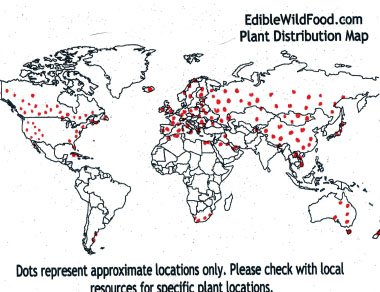

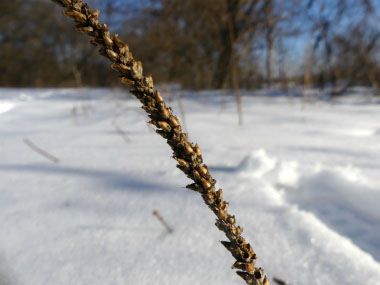
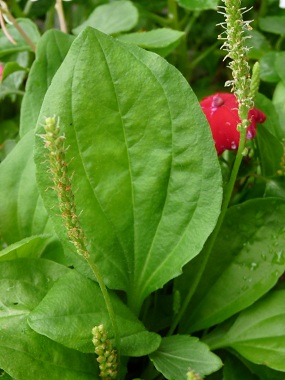
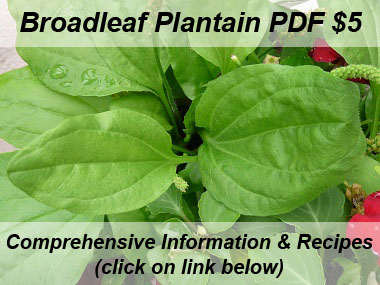
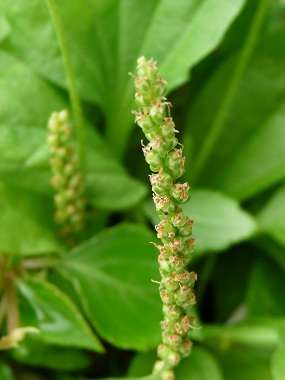
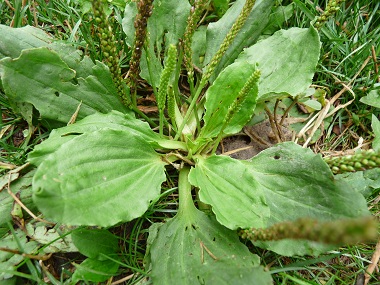
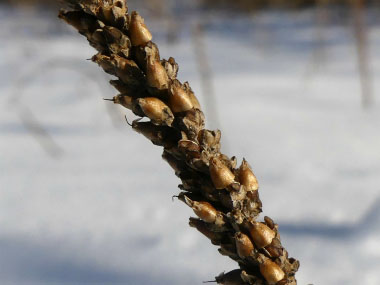
For comprehensive information (e.g. nutrition, health benefits, recipes, history, harvesting tips, etc.) please check out our Broadleaf Plantain PDF magazine.
Broadleaf Plantain is a perennial broadleaf plant that grows in many locations from spring to autumn. Not only is this a vital wild edible plant for overall good health, this wild weed can be used to treat chronic diarrhea as well as digestive tract disorders. Broadleaf plantain is packed with nutrients and is safe to ingest. If a person chomps on some fresh leaves, these can be applied to the skin to treat minor burns, insect bites or open wounds.
Distinguishing Features
Broadleaf plantain has green, oval to egg-shaped leaves that grow in a rosette. These leaves have thick stems that meet at a base. When these stems are broken, they reveal string-like veins that resemble those in celery. Long-pointed, green, petite flowers grow from the base; these also contain a small pod housing dark seeds.
Flowers
Plantain flowers occur in compact spikes on erect, leafless stalks from among the basal leaves. Each spike is about the size and shape of a pencil but consisting of many, tiny, stalkless, greenish flowers giving it a coarsely granular texture. Each flower measures 2 to 3 mm (1/12- 1/8") across. Each flower has four petals, two stamens, and one pistil. Egg-shaped seedpods develop beneath the withering flower.Flowers from spring until late autumn.
 Fields
of Nutrition has medicinal benefits and vitamin/mineral content of Broadleaf Plantain.
Fields
of Nutrition has medicinal benefits and vitamin/mineral content of Broadleaf Plantain.
Leaves
The leaves grow in a rosette and can range from 5 to 30 cm in length. Plantain leaves have stems that contain string-like veins and these veins are seen on the leaf. There are five to seven prominent parallel veins from the base. Leaves are generally broadly lance-shaped to egg-shaped, are hairless or sparsely short haired.
Height
Can grow to a height of 12cm.
Habitat
Can be found growing throughout Ontario and most of North America as well as in Europe and Asia in meadows, pastures, lawns, roadsides, gardens, and waste places.
Edible Parts
The entire plant. Young leaves can be eaten raw or cooked. They are somewhat bitter and tedious to prepare because it’s generally preferable (though not required) to remove the fibrous strands before use. Many people blanch the leaves in boiling water before using them in salads in order to make them more tender. Once blanched, plantain can be frozen then used later in a sauté, soup or stew. Seeds can be eaten raw or cooked and can be tedious to harvest. The seed can be ground into a meal and mixed with flour. Dried leaves make a healthy herbal tea.
Other Name
Common Plantain.
Similar Plants
Recipes
Baked Plantain, Chicken Weed Wrap, Nourishing Skin Salve, Nutty Plantain Snack, Plantain Oil, Plantain Salad, Sesame and Wilted Green Saute, Weed Soup, Wild Pizza
To support our efforts please browse our store (books with health benefits, etc.).
Winter Survival Food Handbook

PDF Plant Magazines
Types of Wild Food
Geographic Zones Seasons
Disclaimer
EdibleWildFood.com is informational in nature. While we strive to be 100% accurate, it is solely up to the reader to ensure proper plant identification. Some wild plants are poisonous or can have serious adverse health effects.
We are not health professionals, medical doctors, nor are we nutritionists. It is up to the reader to verify nutritional information and health benefits with qualified professionals for all edible plants listed in this web site. Please click here for more information.
Why Edible Wild Food?
- Food costs are rising
- Free, wild food is readily abundant
- Wild food adds nutrition to your diet
- Wild food can help treat various medical conditions





